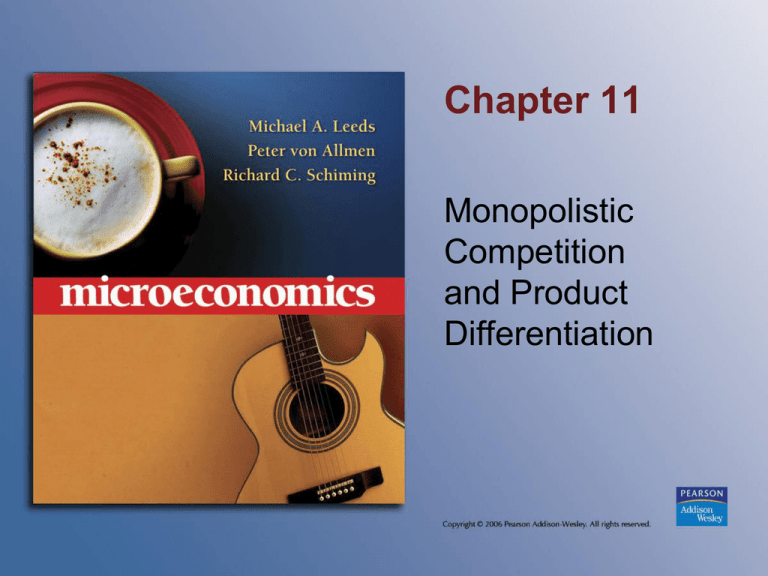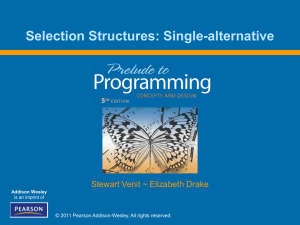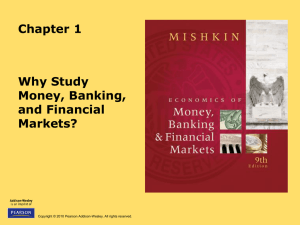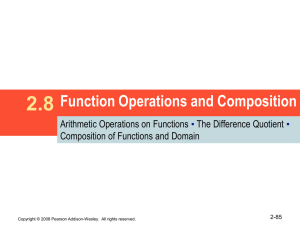
Chapter 11
Monopolistic
Competition
and Product
Differentiation
Assumptions of the Monopolistic
Competition Model
• Free entry and exit in the long run
No barriers to entry
• Many firms, each one small relative to the
size of the market
Firms will have limited market power.
• Each firm produces a differentiated product
Consumers view the goods as close substitutes,
but not perfect substitutes.
Copyright © 2006 Pearson Addison-Wesley. All rights reserved.
11-2
Short-Run Profit Maximization for the
Monopolistic Competitor
• Product differentiation creates a small amount
of market power due to customer loyalty.
Even if the firm raises its price, it will still retain
some of its customers.
Copyright © 2006 Pearson Addison-Wesley. All rights reserved.
11-3
Economic Efficiency
• Is a monopolistic competitive industry
Allocatively efficient?
Productively efficient?
Technologically efficient?
Copyright © 2006 Pearson Addison-Wesley. All rights reserved.
11-4
Figure 11.3 Short-Run Profits
Copyright © 2006 Pearson Addison-Wesley. All rights reserved.
11-5
Loss Minimization
and the Shut-Down Point
• If demand decreases or costs increase,
profits will fall.
If the demand curve just touches the ATC curve
at the profit-maximizing level of output, the firm
will earn normal economic profits.
If the demand curve just touches the AVC curve
at the profit-maximizing level of output, the
firm will be indifferent between operating and
shutting down.
Copyright © 2006 Pearson Addison-Wesley. All rights reserved.
11-6
Figure 11.4 Minimizing Losses and
Reaching the Shutdown Point
Copyright © 2006 Pearson Addison-Wesley. All rights reserved.
11-7
Monopolistic Competition in the Long Run
• In the short run, monopolistically competitive
firms behave much like a monopolist.
• In the long run, however, monopolistic
competition differs from monopoly because
of free entry into the market.
Copyright © 2006 Pearson Addison-Wesley. All rights reserved.
11-8
Firm Entry in Monopolistic Competition
• If firms in a monopolistically competitive
market are earning positive economic profits,
then new firms will enter the market.
Similar to perfect competition
Copyright © 2006 Pearson Addison-Wesley. All rights reserved.
11-9
Figure 11.5 Effects of New Entrants on the
Demand for Cheesesteaks at John’s Roast Pork
Copyright © 2006 Pearson Addison-Wesley. All rights reserved.
11-10
Firm Entry in Monopolistic Competition
• An important difference between monopolistic
competition and perfect competition is that
price does not fall to the minimum point on
the long-run average cost curve.
The firms are not efficient.
Copyright © 2006 Pearson Addison-Wesley. All rights reserved.
11-11
Summary of Monopolistic Competition
• Each firm maximizes profits by producing the
output for which MR = MC.
Price is determined by the demand curve.
• Long-run entry implies that firms will be driven
towards zero economic profits in the long run.
P = LAC
• Price will be greater than the minimum point
of LAC.
• Firms have different demand and costs,
leading to long-run turnover of firms.
Copyright © 2006 Pearson Addison-Wesley. All rights reserved.
11-12
Allocative Efficiency
• For monopolistically competitive firms,
the profit-maximizing level of output is
less than that which minimizes LAC.
Monopolistically competitive firms are not
as efficient as perfectly competitive firms.
Copyright © 2006 Pearson Addison-Wesley. All rights reserved.
11-13
Figure 11.6 The Long-Run Monopolistic
Competition Equilibrium Versus the
Perfect Competition Equilibrium
Copyright © 2006 Pearson Addison-Wesley. All rights reserved.
11-14
Excess Capacity
• As a result of underproduction at
both the firm and industry level,
monopolistically competitive firms are
said to exhibit excess capacity.
Output could be increased without any
firms earning losses.
Copyright © 2006 Pearson Addison-Wesley. All rights reserved.
11-15
The Benefits of Variety
• Is the reduction in efficiency associated
with monopolistic competition bad
for society?
• Not necessarily:
Because consumers value variety, the
benefits of product differentiation may
offset the costs of excess capacity.
Copyright © 2006 Pearson Addison-Wesley. All rights reserved.
11-16
Table 11.1 Summary of Market Structure
Characteristics for Perfect Competition,
Monopolistic Competition, and Monopoly
Copyright © 2006 Pearson Addison-Wesley. All rights reserved.
11-17
Advertising: Information or Persuasion?
• Unlike perfectly competitive firms or
monopolists, monopolistically competitive
firms will advertise to inform customers about
their product.
Copyright © 2006 Pearson Addison-Wesley. All rights reserved.
11-18
Brand Identity and Brand Loyalty
• The goal of advertising is to create:
Brand Identity—the consumer’s ability to
recognize a product and associate it with a
specific name.
Brand Loyalty—a consumer’s willingness
to remain with a specific product despite
the existence of competing products.
• Makes demand less elastic
Copyright © 2006 Pearson Addison-Wesley. All rights reserved.
11-19
Types of Advertising
• Informational—increases consumers’
knowledge of important product
characteristics and price.
• Persuasive—attempts to alter consumer
tastes and preferences by using
subjective information.
Copyright © 2006 Pearson Addison-Wesley. All rights reserved.
11-20
Figure 11.7 Effect of Advertising on the
Demand for John’s Cheesesteaks
Copyright © 2006 Pearson Addison-Wesley. All rights reserved.
11-21
Advertising Product Characteristics
• Product characteristics will determine
how a product is advertised.
Search goods have characteristics
that can be described and easily verified
by consumers.
• Advertised through informational advertising
Experience goods have to be consumed
before a consumer can determine
their characteristics.
• Advertised using persuasive advertising
Copyright © 2006 Pearson Addison-Wesley. All rights reserved.
11-22
Life Lessons
• Taste tests show that most consumers
cannot tell the difference between colas.
Think twice before paying full price for a
brand name soda.
Copyright © 2006 Pearson Addison-Wesley. All rights reserved.
11-23
Strategy and Policy
• Something old, something new, all in
the same box.
Cereal manufacturers believed that
changing the names of cereals might make
people think they were not purchasing
high-sugar content cereal.
Copyright © 2006 Pearson Addison-Wesley. All rights reserved.
11-24
Summary
• Monopolistic competition is defined as a
large number of firms producing a
differentiated product in a market with
free entry.
• A monopolistically competitive firm
maximizes profit by producing the level
of output for which MR = MC.
Price is then determined by the
demand curve.
Copyright © 2006 Pearson Addison-Wesley. All rights reserved.
11-25
Summary (cont’d)
• In the long run, because of free entry
and exit, monopolistically competitive
firms will earn zero economic profits.
• Monopolistically competitive firms
are less efficient than perfectly
competitive firms.
Excess capacity
• Product differentiation offsets some of
the loss of efficiency.
Copyright © 2006 Pearson Addison-Wesley. All rights reserved.
11-26
Summary (cont’d)
• Firms use adverting to differentiate their
product from competing products.
Informational
Persuasive
Copyright © 2006 Pearson Addison-Wesley. All rights reserved.
11-27






